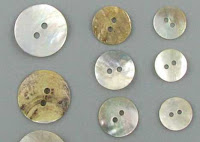11:10 AM
ENLARGE TO FULL SIZE BY CLICKING ON THE IMAGE Above- Thomas Kensett & Co. Oyster & Fruit Packers, Baltimore Maryland circa 1861-2.Since I do not have a photograph of Price & Littig's cannery that packed the case found aboard the Arabia, let me offer this peek into another Baltimore cannery. Kensett's Cannery was perhaps the largest one and directly across the Inner Harbor from where Arabia's case was canned. This areas is now near or under the Baltimore Aquarium.
Notice there are several expansions to this long building and the man displaying the stenciled wooden box.
Greg Hawley measured an oyster can for me and to my surprise according to catalogues in the Hagley Library this size were meant for fruits not oysters. I guess this shows how important it is to have an artifact and not depend specifically on printed material.
This picture was taken to celebrate formalizing a partnership between the three businessmen. One of these men is Thomas Kensett Jr, who's father started the firm perhaps in the two store building first. Thomas Kensett Sr. was credited with patenting a tin can in 1825 before moving to Baltimore. As you can see by their add, he manufactured cans as well as packing oysters in the cooler months and fruit during the harvest season.
Notice the painted signage on the brick behind the partners. I believe the bearded man is Thomas Kensett.
ENLARGE TO FULL SIZE BY CLICKING ON THE IMAGE
Oyster Canning was actively done on this day....
Schooners docked in a narrow canal, between the cannery and other warehouses, unloading oysters from the Chesapeake bay. I recall in a woodcut in Ballou's (Newspaper) that the work force were mostly blacks; whether slave or freeman is debatable. The oysters would be slightly steamed to ease the opening of the shell and the discarded shells were piled higher than the 8-10 foot fence, possibly waiting to be resold to other businesses who made everything from oyster shell buttons, filling in pot holes or inlaid pearl decorative items.
After packing cans, cases would loaded on the wagon and sent to the retail & wholesale store.
Notice the wood crate has been cut away to show new shiny canned oysters. (I think the two story building was the earliest structure) Remember to enlarge by clicking the image

Arabia's case, was loaded aboard the B & O railroad and arrived at the St Louis Levee at the B & O Railroad Agency [Depot] next to Arabia's 1st Clerk's store [Nicholas Springer].










0 comments:
Post a Comment